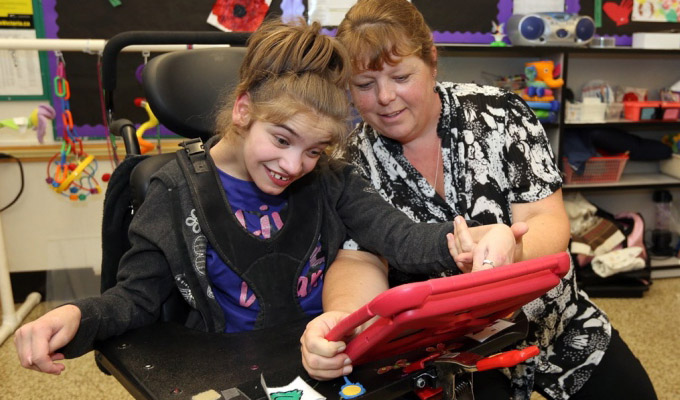
1. Isn’t assistive technology best for students with cognitive impairments?
Assistive technology is used every day by people with and without disabilities. When you type on your phone, word prediction software helps you text faster. When you are at the gym, the closed caption on the television allows you to hear what is being said on your favorite reality show. Assistive technology evaluations determine the student’s abilities, needs, environment, and goals. Nondisabled students, students with 504 Plans, mental health struggles, autism, dyslexia, learning disabilities, and more can benefit from the support that technology can offer.
2. My child is in mainstream classes. Is assistive technology for her?
Yes, the goal of assistive technology is to provide a more inclusive environment for all students. Technology can provide access to grade-level curriculum and social interactions. With appropriate teacher training, more students will be able to be successful and meet grade-level goals.
3. Do my students need an assistive technology evaluation? We have Chromebooks in our classroom.
Having access to Chromebooks is wonderful for all students, but Chromebooks, in and of themselves, are not assistive technology. Chromebooks in today’s classroom can be compared to textbooks in classrooms ten years ago. They provide educational value and can provide accommodations and modifications for students, but they still need to be customized for each learner. Many students with disabilities will find extensions and add-ons helpful, but students need assistance navigating the tools and receive training.
4. Why is it suggested that the evaluator work with the student even after the evaluation?
The evaluation process involves reviewing documentation, observations, parental and staff discussions and the actual evaluation. One of the most important deterrents from technology device abandonment is the trial period. This period provides training on the device, its multiple applications, training staff and family, and observing the student interaction with the assistive technology. In order to ensure that student independence and success is attainable, the trial period is necessary.
5. Isn’t assistive technology only to help students that cannot read?
Assistive technology is a tremendous support for students that cannot read on grade level. Assistive technology can also support executive functioning difficulties, math, writing, mental health, behavioral support, physical disabilities, learning disabilities, chronic illness, and more. High tech and low-tech options are available at a variety of costs and training depending on the needs of the learner. Workplace readiness is also another great use for assistive technology.
6. If the student has the technology, they will never learn the skills being taught.
This statement is not entirely true. For some, assistive technology is similar to someone with a broken leg. Once the leg is healed, the cane is taken away. Students that utilize assistive technology may find that over time, the need for the support is lessened or changed. Other students are similar to a person that will not be able to walk. Their wheelchair may provide access to experiences and success that may not have been available without it. Consider the student, the environment, and the skill prior to dismissing the support of assistive technology. A long-term plan to fade the technology can always be included.
7. I am afraid that the other students will make comments.
Technology is all around. People take pictures of what they eat every day and engage in social media numerous times a day. Ten years ago, a student with a desktop computer would draw significant attention. In today’s classroom, students regularly use low and high technology throughout the day. A student that takes a picture of notes on the board or wears a small earbud can easily be included.
8. Isn’t assistive technology cheating?
Assistive technology is not cheating and should be acknowledged just like support for any other person with a disability. Wearing glasses when you have a visual impairment is not cheating and neither is listening to a text when you have a print-based disability. It is important to understand that not all people read with their eyes. Others access the information with their ears. Consider the learning objective when determining if the access is appropriate. Generally, students with reading difficulties are evaluated no sooner than fourth grade. Many curriculums shift the focus from learning to read, to reading to learn. A student that cannot read will struggle to learn without support. Please note, the reading instruction in conjunction with technology supports, may still be provided based on the recommendation of the child study team.
9. What happens when students participate in standardized testing?
Many standardized tests, such as state assessments, permit technology accommodations for students with and without disabilities. Discuss these options with your child study team or assistive technology evaluator.
10. My child is 16, is he too old for technology supports?
No learner is too old for supports that will provide greater independence and success. Many tools are available to help learners in the work environment, leisure activities, and daily living skills.
By: Learning for Tomorrow. To learn more, go to https://lftnj.com/.


